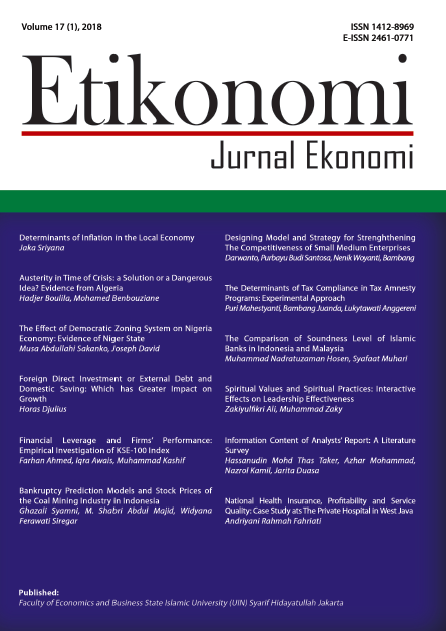Foreign Direct Investment or External Debt and Domestic Saving: Which has Greater Impact on Growth
DOI:
https://doi.org/10.15408/etk.v17i1.7120Keywords:
foreign direct investment, domestic saving, external debt, economic growthAbstract
The choice taken by developing countries in meeting the lack of development funds has a varying effect. This study clarifies the role of foreign direct investment (FDI) compared to foreign loans and domestic savings in short- and long-term economic growth of Indonesia. Data were obtained from World Bank and Bank Indonesia and used in error correction model to explain the linkage between predictors and economic growth. We show that in the short run, the three explanatory variables significantly affect economic growth. In the long run, compared to FDI and foreign loans, domestic savings positively and significantly affect economic growth. This study emphasizes the importance of sustaining domestic savings to maintain the stability of economic fundamentals in the long term.
Downloads
References
Abbes, S.M., Mostéfa, B., Seghir, G.M., & Zakarya, G.Y. (2015). Causal Interactions Between FDI and Economic Growth: Evidence from Dynamic Panel Co-Integration. Procedia Economics and Finance. Vol. 23: 276-290. DOI: https://doi.org/10.1016/S2212-5671(15)00541-9.
Aghion, P., Comin, D., Howitt, P., & Tecu, I. (2016). When Does Domestic Savings Matter for Economic Growth? IMF Economic Review. Vol. 64(3): 381–407.
Ajayi, L.B. & Oke, M.O. (2012). Effect of External Debt on Economic Growth and Development of Nigeria. International Journal of Business and Social Science. Vol. 3(12): 297–304.
Almfraji, M.A., & Almsafir, M.K. (2014). Foreign Direct Investment and Economic Growth Literature Review From 1994 to 2012. Procedia-Social and Behavioral Sciences. Vol. 129: 206-213. DOI: https://doi.org/10.1016/j.sbspro.2014.03.668.
Apergis, N., Lyroudi, K. & Vamvakidis, A. (2008). The Relationship Between Foreign Direct Investment and Economic Growth: Evidence from Transition Countries. Transition Studies Review. Vol. 15(1): 37–51.
Atique, R. & Malik, K. (2012). Impact of Domestic and External Debt on The Economic Growth of Pakistan. World Applied Sciences Journal. Vol. 20(1): 120–129.
Budha, B. (2012). A Multivariate Analysis of Savings, Investment and Growth in Nepa. MPRA Paper No. 43346.
Ezeabasili, V.N., O. Isu, H. & Mojekwu, J.N. (2011). Nigeria’s External Debt and Economic Growth: An Error Correction Approach. International Journal of Business and Management. Vol. 6(5): 156–170.
Farhana, P. (2014). Impact of Foreign Debt on Growth in Bangladesh: an Econometrics Analysis. International Journal of Developing and Emerging Economics. Vol. 2(4): 1–24.
Ijirshar, V.U., Joseph, F. & Godoo, M. (2016). The Relationship Between External Debt and Economic Growth in Nigeria. International Journal of Economics & Management Sciences. Vol. 6(1): 1–5.
Jagadeesh, D. (2015). The Impact of Savings in Economic Growth: An Empirical Study Based on Botswana. Vol. 2(9): 10–21.
Jangili, R. (2012). Causal relationship between saving, investment and economic growth for India – what does the relation imply? MPRA Paper No. 40002.
Javaid, W. (2016). Impact of Foreign Direct Investment on Economic Growth of Pakistan An ARDL-ECM Approach. (Unpublished Dissertation). Sweden: Umea University Sweden. Retrieved from http://sh.diva-portal.org/smash/get/diva2:944306/FULL TEXT01.pdf.
Lean, H.H., & Song, Y. (2009). The Domestic Savings and Economic Growth Relationship in China. Journal of Chinese Economic and Foreign Trade Studies. Vol. 2 (1): 5-17. DOI: https://doi.org/10.1108/17544400910934315.
Najarzadeh, R., Reed, M. & Tasan, M. (2014). Relationship Between Savings and Economic Growth: The Case For Iran. Journal of International Business and Economics. Vol. 2(4): 107–124. Available at: http://dx.doi.org/10.15640/jibe.v2n4a7.
Osinubi, T.S. & Amaghionyeodiwe, L.A. (2010). Foreign Private Investment and Economic Growth in Nigeria. Applied Econometrics and International Development. Vol. 10(2): 105–127.
Oteng-Abayie, E.F. & Frimpong, M.J. (2006). Bounds Testing Approach to Cointegration: An Examination of Foreign Direct Investment Trade and Growth Relationships. American Journal of Applied Sciences. Vol. 3 (11): 2079–2085.
Das, U.S., Papapioannou, M., Pedras, G., Ahmed, F., & Surti, J. (2010). Managing public debt and its financial stability implications. IMF Working Paper No. WP/10/280. Washington DC: IMF.
Rahman, M.M. & Shahbaz, M. (2011). Do Imports and Foreign Capital Inflows Lead Economic Growth? Cointegration and Causality Analysis in Pakistan. Munich Personal RePEc Archive, MPRA Paper.
Rjoub, H. (2017). The Impact of FDI Inflows on Economic Growth: Evidence From Landlocked Countries in Sub-Saharan Africa. Journal of Social Sciences. Vol. X(1): 153–168.
Roy, S. & Mandal, K. (2012). Foreign Direct Investment and Economic Growth : An Analysis for Selected Asian Countries. Journal of Business Studies Quarterly. Vol. 4(1): 15–24.
Saqib, N., Masnoon, M. & Rafique, N. (2013). Impact of Foreign Direct Investment on Economic Growth of Pakistan. Advances in Management and Applied Economics. Vol. 3(1): 35–45.
Siddique, A., Selvanathan, E.A., & Selvanathan, S. (2015). Economics the Impact of External Debt on Economic Growth: Empirical Evidence From Highly Indebted Poor Countries. Vol. 4(8): 1–31.
Tang, C.F. & Ch’ng, K.S., 2012. A Multivariate Analysis of the Nexus between Savings and Economic Growth in the ASEAN-5 Economies. Margin: The Journal of Applied Economic Research. Vol. 6(3): 385–406.
Tang, C.F. & Lean, H.H. (2013). The Role of Savings on Economic Growth in Malaysia: a View from Generalized Variance Decomposition Analysis. Economic Computation and Economic Cybernetics Studies and Research. Vol. 3(47): 199–214.
Zouhaier, H. & Fatma, M. (2014). Debt and Economic Growth. International Journal of Economics and Financial Issues. Vol. 4(2): 440–448.










